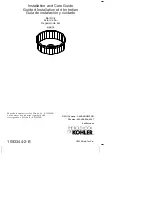
19
DC7000 ANTIQUE
Smear all ‘O’ rings with silicon grease prior to
installing them. Torque the valve cover to 13 Nm
(10 lb.ft.). This is to prevent inadvertently
unscrewing the cover during temperature
adjustment. Do not over-tighten the valve cover or
the mounting arrangement may be damaged.
e)
Replace the ‘O’ rings every three years –
maintenance kits with spare ‘O’ rings are
available. Smear silicon grease on all ‘O’ rings
before assembling. At the same time replace the
slide valve assembly (fig.34). Lightly smear the
outside diameter with silicon grease before
installing.
f)
Replace the thermostatic element (fig.34) at
least once every six years, or more often if
problems are experienced or in installations where
water is particularly hard.
g)
The on/off mechanism (fig.35) has a 1/2” tap
washer which should be replaced when it is found
to be leaking. Remove the trim plate and unscrew
the on/off assembly. The washer is retained by a
small nut. When replacing, do not overtighten –
torque to 25Ncm. Ensure the on /off assembly is
torqued down to 13Nm (10 lb.ft.) to prevent the
user from inadvertently unscrewing the assembly
during flow control. Do not over-tighten the
assembly or the mounting arrangement may be
damaged.
h)
The non return valves (NRVs) prevent cross-
flow between hot and cold supplies under
unequal pressure conditions. They are designed
for long life with no maintenance. Their function
can be tested as follows:
i)
To test the NRV on the hot side, shut off the
hot supply and ensure the cold supply is open. Be
prepared for leakage of trapped water in the pipe
and remove the strainer basket on the hot side.
Evidence of continuing leakage from the strainer
body is coming through the hot supply NRV.
j)
To test the NRV on the cold side, shut off the
cold supply and ensure the hot supply is open. Be
prepared for leakage of trapped water in the pipe
and remove the strainer basket on the cold side.
Evidence of continuing leakage from the strainer
body is coming through the cold supply NRV.
If either NRV is leaking then the inlet elbow –
complete with NRV and strainer basket, should be
replaced. It is not possible to satisfactorily remove
the NRV itself from the elbow and should not be
attempted.
IN-SERVICE TESTING
Periodic testing should be undertaken to check
whether deterioration has occurred in the
performance of the mixer valve.
A thermal shut off test, as described under
maintenance, should be carried out. If water
coming from the shower head is at a temperature
of more than 2°C above the maximum mixed
water temperature setting then the valve unit is
due for maintenance.
NOTE: A thermostatic mixing valve in need of
maintenance can be undetectable in normal use
and only becomes apparent when a disruption
occurs in the hot or cold water supply
temperatures or pressures.
The frequency of in-service testing depends upon
the water condition passing through the unit. In-
service testing should be between six to twelve
months, but less than six month intervals in areas
of hard water.
Experience of local conditions and the in-service
testing record will dictate the frequency of in-
service testing.
Содержание DC7000 Antique
Страница 2: ...DC7000 ANTIQUE UKAS QUALITY MANAGEMENT 003...
Страница 25: ...23 DC7000 ANTIQUE...
Страница 26: ...DC7000 ANTIQUE 24...
Страница 27: ......








































